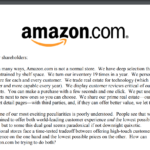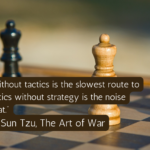Photo by Jens Johnsson from Pexels
As a product manager, one of the most important aspects of your job is making decisions that will drive the success of your product. However, it’s not always easy to know what the right decision is, and even the most experienced product managers can sometimes make mistakes.
Why it’s important for a product person to be more often right?
People look for product managers who are more often right because they want to ensure that the products they are investing in or using will be successful. A product manager who makes the right decisions more often is more likely to create a product that meets customer needs is competitive in the market and is aligned with the overall goals and objectives of the organization.
Additionally, a product manager who makes the right decisions more often is more likely to be able to effectively manage the product development process, which can lead to faster time to market and lower development costs. This can ultimately lead to increased revenue and profitability for the organization.
Another important aspect of being a product manager who is more often right is the ability to reduce the risk of product failure. A product that does not meet the customer’s needs or does not align with the market trends can lead to significant financial losses for the company. A product manager who is more often right can minimize these risks and help the company to increase its market share and profitability.
So, how can you increase your chances of making the right decisions as a product manager?
1. Conduct Thorough Market Research
The first step in making informed decisions is to understand your customers and the market you’re operating in. This means conducting thorough market research to identify customer needs, pain points, and trends in the industry. By understanding your customers, you’ll be better equipped to make decisions that align with their needs and preferences. There are several methods for conducting market research, including:
- Surveys: Surveys can be used to gather information from a large number of people in a short amount of time. Surveys can be conducted online, by phone, or in person, and can be used to gather information on customer needs, pain points, and preferences.
- Interviews: Interviews are a more in-depth way to gather information from customers, and can be used to gain a deeper understanding of their needs and pain points. Interviews can be conducted in person, by phone, or via video conferencing.
- Focus Groups: Focus groups are a way to gather information from a group of people in one place. They can be used to gather information on customer needs, pain points, and preferences, and can also be used to test new product concepts.
- Competitor Analysis: Analyzing the competition can provide valuable insights into the market and help you understand what’s working and what’s not. This can include researching their products, pricing, marketing strategies, and customer feedback.
- Industry Research: Researching industry trends, publications and reports can give you an overview of the market, and latest advancements.
- User Testing: User testing allows you to test a product or prototype with a group of users to gather feedback and identify areas for improvement.
2. Gather Feedback
Another important step in making the right decisions is to gather feedback from a variety of stakeholders, including customers, sales teams, and other members of your organization. This feedback can help validate your assumptions and ideas, and can also provide valuable insights into what is and isn’t working. There are several methods for gathering feedback, including:
- Customer feedback: Collecting feedback from customers through surveys, interviews, or focus groups can provide valuable insights into their needs, pain points, and preferences. This can help you make decisions that align with their needs and improve the overall customer experience.
- Sales team feedback: Sales teams are often in direct contact with customers and can provide valuable insights into the market and customer needs. They can also provide feedback on the effectiveness of your product and any areas that need improvement.
- Employee feedback: Gathering feedback from employees can provide valuable insights into the internal processes and procedures of your organization. This can help you identify areas for improvement and make decisions that align with the overall goals and objectives of the company.
- User testing: User testing allows you to test a product or prototype with a group of users and gather feedback on its usability, functionality, and design. This can help you identify areas for improvement and make decisions that align with the needs of your target audience.
- Social Media Monitoring: Social media monitoring can provide you with insights into the customer’s voice and their feedback on your product.
- Product usage data: Collecting data on how customers are using your product can provide valuable insights into what features are being used, what features are being ignored, and what features need to be improved.
3. Use Data and Analytics
Data and analytics can also play a critical role in decision-making. By tracking key metrics such as user engagement, conversion rates, and revenue, you’ll be able to make data-driven decisions that are more likely to lead to success. There are several methods for using data and analytics, including:
- Tracking key metrics: Key metrics such as user engagement, conversion rates, and revenue can provide valuable insights into the performance of your product. By tracking these metrics, you’ll be able to identify areas for improvement and make decisions that drive success.
- A/B testing: A/B testing allows you to test different variations of a product or feature to see which one performs better. This can help you identify which features are most important to your customers and make decisions that align with their needs.
- Cohort analysis: Cohort analysis allows you to track the behavior of specific groups of users over time. This can provide valuable insights into how different segments of your customer base are interacting with your product and can help you make decisions that align with the needs of these segments.
- Funnel analysis: Funnel analysis allows you to track the user journey through your product and identify where users are dropping off. This can help you identify areas of your product that need improvement and make decisions that drive engagement and conversion.
- Heat maps and session recordings: Heat maps and session recordings allow you to see how users are interacting with your product and identify areas of improvement.
- Customer segmentation: Segmenting your customer base and tracking the behavior of each segment can provide valuable insights into the needs of different segments of your customer base.
4. Stay Up-to-Date with Industry Trends
In order to stay competitive and make the right decisions, it’s important to stay up-to-date with the latest industry trends and technologies. This means reading industry publications, attending conferences, and networking with other product managers and industry experts. Here are several methods for staying up-to-date with industry trends:
- Reading industry publications: There are many industry-specific publications that cover the latest trends, developments, and news. Reading these publications can help you stay informed about the industry and identify new opportunities for your product.
- Attending conferences and events: Attending conferences and events can be a great way to stay up-to-date with the latest industry trends and developments. This can also be a great opportunity to network with other product managers and industry experts.
- Following thought leaders: Following thought leaders in the industry on social media or in their blog can help you stay informed about the latest trends, developments and best practices.
- Joining online communities: Joining online communities, such as LinkedIn groups or forums can be a great way to stay up-to-date with industry trends and connect with other product managers and industry experts.
- Keeping up with technology advancements: Technology advancements can disrupt industries and change the way product are built and marketed. Keeping up with advancements in technology can help you identify new opportunities for your product and make decisions that align with the latest trends.
- Experimenting: Experimenting with new technologies and features can help you stay up-to-date with industry trends and identify new opportunities for your product.
5. Build Strong Cross-Functional Relationships
As a product manager, you’ll be working with a variety of different teams and stakeholders, including engineering, design, marketing, and sales. Building strong cross-functional relationships can help you gain valuable insights from other areas of the company and make better decisions as a result. Here are several methods for building strong cross-functional relationships:
- Regular meetings and check-ins: Having regular meetings and check-ins with members of other teams can help you stay informed about their work, and understand how it relates to your product. This can also help you identify areas where you can collaborate and make decisions that align with the overall goals of the company.
- Collaborative problem-solving: Collaborating with members of other teams to solve problems and overcome challenges can help you build strong relationships and make better decisions.
- Joint project work: Working on joint projects with members of other teams can help you build strong relationships and gain valuable insights into their work.
- Communicate effectively: Communicating effectively with members of other teams can help you build strong relationships, and make sure that everyone is on the same page when it comes to your product.
- Building trust and respect: Building trust and respect with members of other teams can help you build strong relationships and gain their support when making decisions.
- Embrace diversity of thought: Building relationships with people from different backgrounds and departments can help you gain different perspectives and make better decisions.
6. Learn from Your Mistakes
No one is perfect, and even the most experienced product managers make mistakes. The key is to learn from your mistakes and adjust your strategy accordingly. Be open to feedback and be willing to change course if necessary. Here are several methods for learning from your mistakes:
- Reflect on your decisions: Reflecting on your decisions and considering what you could have done differently can help you identify areas for improvement and make better decisions in the future.
- Seek feedback: Seeking feedback from others can help you gain a different perspective on your mistakes and identify areas for improvement.
- Identify patterns: Identifying patterns in your mistakes can help you identify common themes and make better decisions in the future.
- Use failure as learning opportunities: Failure can be a great teacher, instead of getting discouraged, use it as an opportunity to learn and improve.
- Keep a journal: Keeping a journal of your decisions, the feedback you received and your reflections can help you track your progress and identify patterns in your mistakes.
- Be open to change: Being open to change and willing to adapt your approach can help you learn from your mistakes and make better decisions in the future.
7. Have a Clear Product Vision and Strategy
Having a clear product vision and strategy can also help guide decision-making and prioritize what is most important for the company and customers. This will help you make decisions that align with the overall goals and objectives of the organization.
Here are several methods for having a clear product vision and strategy:
- Define your product vision: Defining a clear vision for your product can help you make decisions that align with the overall goals and objectives of the company. This vision should be a statement that describes what the product will look like in the future and how it will solve customer’s needs.
- Prioritize product road-map: Prioritizing your product roadmap can help you make decisions that align with the overall goals and objectives of the company and prioritize what is most important for the company and customers. This can be done by creating a backlog of features and functions, and organizing them based on priority.
- Communicate your vision and strategy: Communicating your vision and strategy to all stakeholders, including customers, employees, and stakeholders can help you gain their support and make sure everyone is on the same page when it comes to your product.
- Align with company’s goals: Aligning your product vision and strategy with the overall goals of the company can help you make decisions that align with the overall goals and objectives of the company.
- Measure progress: Measuring progress against your vision and strategy can help you identify areas for improvement and make decisions that align with the overall goals and objectives of the company.
- Be flexible: Being flexible and willing to adapt your vision and strategy as necessary can help you make decisions that align with the overall goals and objectives of the company and ensure that your product stays relevant.
8. Be a Good Listener
Finally, one of the most important qualities of a good product manager is being a good listener. Be open to new ideas, and be willing to consider different perspectives. By being a good listener, you’ll be more likely to make the right decisions
Being a good listener is an important aspect of being a successful product manager. It allows you to gain valuable insights from others, understand different perspectives and make better decisions. Here are several methods for being a good listener:
- Pay attention: Paying attention to what others are saying, and actively listening to their ideas and feedback can help you gain valuable insights and make better decisions.
- Ask questions: Asking open-ended questions can help you understand different perspectives, and gain a deeper understanding of the issues at hand.
- Avoid interrupting: Avoid interrupting others when they are speaking, this shows respect and allows them to fully express their thoughts.
- Show empathy: Showing empathy towards others and understanding their point of view can help you build stronger relationships and make better decisions.
- Take notes: Taking notes can help you remember important information and ideas and also show that you are engaged in the conversation.
- Avoid biases and prejudices: Being a good listener also means being open to different perspectives, avoiding biases and prejudices, and not making assumptions about others.
By following all these steps, you’ll be well on your way to making better decisions and driving the success of your product.


Mangesh is Product Leader
Full Bio here – https://mangesh.bhamre.in











